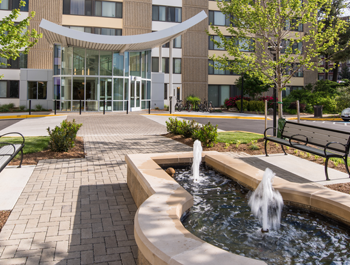Image

J. Michael Pitchford, President and CEO, CPDC
Luann Tia Blount, Vice President of External Relations, CPDC
Challenge: Deep-rooted social ills including poverty, crime, substandard housing and inadequate economic resources are often intertwined and significantly impact how members of a community interact and behave. Sometimes making physical renovations and providing resident services can begin to shift the culture, but sometimes it's not enough.
In 1995, The Community Preservation and Development Corporation (CPDC) acquired Edgewood Terrace, an apartment community in Washington, D.C., with nearly 800 homes and more than 1,000 residents. Some had dubbed the community "Little Beirut" because of the level of violence and disinvestment throughout the property. While development and management of quality affordable housing is our main business, CPDC recognizes that quality living extends beyond the four walls of a home and offers on-site programs that connect residents, and those in the surrounding communities to the resources they need to improve their quality of life. We knew that we faced a difficult challenge — changing perceptions, improving the quality of the housing assets and helping to connect residents to each other in more positive ways. We took the challenge head on.
Since acquiring the property in the mid-1990s, CPDC completely revitalized the buildings and interior landscape, partnered with residents and police to address safety concerns and brought in a range of programs, services and amenities.
Edgewood Terrace became CPDC's flagship community, earning national recognition as the first affordable housing community in D.C. to offer free Internet access to residents—an effort made possible in partnership with Microsoft Corporation. Edgewood was also widely recognized for its early investments in programs geared toward technology, youth development, adult literacy, workforce development and senior care.
But free Internet and the availability of programs isn't enough. Despite these investments, many Edgewood Terrace residents continued to live in isolation and fear. A walk across the property revealed a campus separated by fences left over from an earlier renovation; residents avoiding eye contact with one another and being reluctant to use playgrounds and other outdoor amenities; and little to no interaction between residents and the staff charged with keeping the community clean, safe and in compliance.
 In 2013, the 20-year Housing Assistance Payment contract at Edgewood Terrace was up for renewal. There were also market forces in the broader Edgewood-Brookland neighborhood pushing for the conversion of affordable units to be available at market rate. Likewise, the entire Edgewood campus — four separately financed deals — was in need of revitalization.
In 2013, the 20-year Housing Assistance Payment contract at Edgewood Terrace was up for renewal. There were also market forces in the broader Edgewood-Brookland neighborhood pushing for the conversion of affordable units to be available at market rate. Likewise, the entire Edgewood campus — four separately financed deals — was in need of revitalization.CPDC began planning a $50 million reinvestment to upgrade units, renovate the buildings' interiors and exteriors, remove physical barriers on the property, and add new features such as a fitness trail, a community garden, and water features designed to bring residents and community members together. The community was rebranded as "Edgewood Commons" with the goal to create an economically diverse community and, most importantly, address the operating culture through trust-building and collaborative action.
CPDC partnered with Trusted Space, a North Carolina company that focuses on creating positive change at the community level, to develop ONE Edgewood Network. The community engagement model connects resident to resident, resident to neighbor, and resident to CPDC staff and property management. Through this, CPDC removes barriers, builds trust, and enhances residents' quality of life, creating a greater and deeper sense of community.
CPDC has been successful at beginning to change the environment at Edgewood Commons. Residents now take consistent self-directed actions to improve the physical and social environment. These steps include: an active community network with over 150 active resident members; 40 residents consistently participate in monthly community meetings; the introduction of 40 resident-led initiatives; residents applied for (and won) a $2,000 NeighborWorks Community Building Grant to increase the involvement of 16-24 year olds at Edgewood and one resident was appointed Advisory Neighborhood Commissioner for the local Ward in D.C.
CPDC's strategy involved a four-step process and reflects the lessons learned through developing and implementing this model:
- Understand the importance of an interdependent vs. an altruistic framework: Shifting away from the notion that "poor people need professionals to provide them with housing and social programs to pursue a quality life" and embracing the belief that to create high quality places to live and work. It is important to recognize that everyone in a given eco-system (residents, staff, partners) has something to contribute and is interdependent on one another to achieve high-quality living.
- Seek to change the operating culture instead of starting a new program: Focusing their efforts on listening, developing relationships, building trust and understanding the underlying issues behind how they operate as opposed to prescribing interventions.
- Introduce new spaces and practices with quality, zest and consistency. Create highly intentional and efficient spaces in which to practice new behaviors and to spark individual and collective action. Also make room for small groups and in-between relationship building, follow up and consistent opportunities to invite others into the space.
- Form a network (which includes everyone) and not a resident organization. Cultivate a diverse network involving residents, staff, partners and neighbors to increase synergy and greater outcomes.

